January 2007.
Next club meeting Monday 5th February 2007.
- This will be the Club Auction.
We will try to have the lots displayed by 19.l0pm and start the auction just before 8pm in order to be completed by l0pm.
With over 200 lots the auctioneer will set a quite fast pace and begin close to the reserve price. This means there
will be minimum thinking time - so be prepared to bid smartly on items of interest.
All members will be given a bid number, you must sign in to be assigned a bid number.
Please pick up your paddle bid card prior to the start of the auction.
Finally, while some of the lots have been graded it is still up to prospective purchasers to verify the grading
description is to their satisfaction prior to bidding, There will be no returns other than postal lots or coins that
are subsequently shown not to be genuine.
Dealer's tables will not be allowed until after the auction and if time permits.
January meeting.
This meeting was devoted to short talks by members and to award the Mark Myhill memorial shield. Five talks were given.
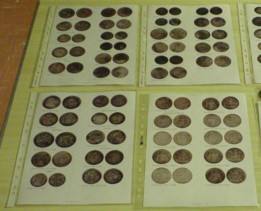 Michael first warned club members to beware of some very high quality modern forgeries
coming out of China. He showed two actual examples and a list compiled by a London dealer showing all the the ones they had so far
encountered. They were struck in good metal (silver or gold) of good weight (within acceptable limits), had very convincing toning
and had fooled many experienced dealers and collectors.
Michael first warned club members to beware of some very high quality modern forgeries
coming out of China. He showed two actual examples and a list compiled by a London dealer showing all the the ones they had so far
encountered. They were struck in good metal (silver or gold) of good weight (within acceptable limits), had very convincing toning
and had fooled many experienced dealers and collectors.
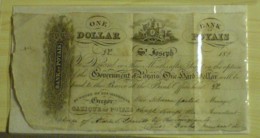 The first talk was by Tony Martin about the "Prince of Poyais". Gregor MacGregor, son
of Gregor the Beautiful was born in Scotland in 1780. He served in the Peninsular war against Napolean and then went on to fight for
Simon Bolivar, helping to liberate South America from Spanish rule. He was so well thought of that he was allowed to marry Bolivar's niece
Josefa. After the war of liberation he turned to piracy. He captured the island of Amelia off the coast of Florida and tried
(unsuccessfully) to sell it to the USA. He then called in at a place called the Mosquito Coast in central America where he got drunk
with a local chief called George Frederick Augustus who gave him 8 million acres of worthless land.
The first talk was by Tony Martin about the "Prince of Poyais". Gregor MacGregor, son
of Gregor the Beautiful was born in Scotland in 1780. He served in the Peninsular war against Napolean and then went on to fight for
Simon Bolivar, helping to liberate South America from Spanish rule. He was so well thought of that he was allowed to marry Bolivar's niece
Josefa. After the war of liberation he turned to piracy. He captured the island of Amelia off the coast of Florida and tried
(unsuccessfully) to sell it to the USA. He then called in at a place called the Mosquito Coast in central America where he got drunk
with a local chief called George Frederick Augustus who gave him 8 million acres of worthless land.
He returned to London and announced himself as Gregor I, cazique (chief) of Poyais. His plan was to raise £200,000 by selling bonds
land and concessions in Poyais. He even sold banknotes for Poyais, one of which Tony showed. He described Poyais as a land of cathedrals,
public buildings and opera houses etc. The capital was St. Joseph, the land fertile and gold found everywhere. People flocked to buy land
and property in this new venture. Gregor now styled himself "Sir Gregor" and opened offices in London, Glasgow, Stirling and Edinburgh.
240 people hired 2 ships and sailed to Poyais. There they found nothing except three broken down shacks. Realising they had been duped
they set out for Belize, 300 miles to the north. Only 50 made it. When the news reached London, MacGregor and his wife fled to
Paris, where they repeated the scam. When the newsreached Paris, he fled to Venezuela, where he lived the rest of his life on a generous
Army pension. He is still remembered in South America for his deeds of valour against the Spanish and his name can be found on a huge statue
in the centre of Caracas.
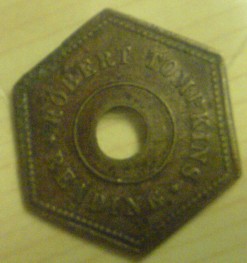 David Pottinger showed a brass 6 sided token with central hole inscribed both sides
"Robert Tompkins Reading". He secured it from Michael who suggested he research it as it was unpublished as far as he knew. Six years
later David did and found out that RT was born in 1833 and moved to Reading in late 1855, setting up as an auctioneer. The earliest
trade directory listing is in 1859, showing him a horse and cattle auctioneer of 18 Oxford St. Reading. In 1860 he moved to 27, Broad St.
in the centre of Reading and 3 years later had expanded his activities to include a horse and carriage repository. In 1869 he moved
to 25, Friar St. (near the Boars Head Pub) and by 1874 had added "Royal" to his business title. In the 1871 census he is listed as living
here with his wife Sarah, 3 daughters and 4 servants. In 1876 and 1877 Hammond and Co. are listed as proprietors of his business but within
5 years he had resumed as proprietor. There followed several changes to the address and details of the business and on 7th February 1897
Tompkins died aged 63, but the business continued to at least 1911 (final directory listing) where motor cars were added to the items
traded.
David Pottinger showed a brass 6 sided token with central hole inscribed both sides
"Robert Tompkins Reading". He secured it from Michael who suggested he research it as it was unpublished as far as he knew. Six years
later David did and found out that RT was born in 1833 and moved to Reading in late 1855, setting up as an auctioneer. The earliest
trade directory listing is in 1859, showing him a horse and cattle auctioneer of 18 Oxford St. Reading. In 1860 he moved to 27, Broad St.
in the centre of Reading and 3 years later had expanded his activities to include a horse and carriage repository. In 1869 he moved
to 25, Friar St. (near the Boars Head Pub) and by 1874 had added "Royal" to his business title. In the 1871 census he is listed as living
here with his wife Sarah, 3 daughters and 4 servants. In 1876 and 1877 Hammond and Co. are listed as proprietors of his business but within
5 years he had resumed as proprietor. There followed several changes to the address and details of the business and on 7th February 1897
Tompkins died aged 63, but the business continued to at least 1911 (final directory listing) where motor cars were added to the items
traded.
The final entry reads "Sales by auction every Saturday, Tompkins Horse and Carriage Repository Ltd., Reading, horses, carriages,
motor cars, agricultural implements, harnesses etc. Horses on private sale and let on hire for any period. Agricultural auctioneers,
valuers and estate agents, commisions faithfully executed, prompt settlements."
Tompkins was a member of the Town Council. The token was presumably used in the auctioneers business to give to casual labour and
dpresumably could be traded at local businesses who would redeem them with Tompkins.
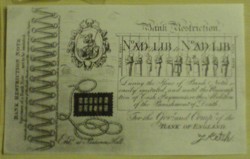 The third talk was by Michael about Cruikshanks Anti-hanging note. The Napoleonic wars
resulted in an upsurge of hoarding and a resulting need for more money. This resulted in the Bank of England hastily producing
£1 and £2 banknotes (previously the smallest denomination was £5) and these were easily forged. Also Prime Minister Pitt passed
the "restriction of cash payment" act which meant that notes could not be converted into cash (coin) until the act was rescinded
(which was not until 1821). As most of the population was illiterate the number of fake banknotes surged to 10,000 and by 1817 the
total value of fake notes in circulation was £37,040. Between 1773 and 1796 only 3 people were capitally convicted of forgery
but between 1797 and 1817 the figure had risen to 313. By 1819 many people (including Cruikshank) blamed the Government and
particularly the Bank of England for this state of affairs and the note was produced to highlight this.
The third talk was by Michael about Cruikshanks Anti-hanging note. The Napoleonic wars
resulted in an upsurge of hoarding and a resulting need for more money. This resulted in the Bank of England hastily producing
£1 and £2 banknotes (previously the smallest denomination was £5) and these were easily forged. Also Prime Minister Pitt passed
the "restriction of cash payment" act which meant that notes could not be converted into cash (coin) until the act was rescinded
(which was not until 1821). As most of the population was illiterate the number of fake banknotes surged to 10,000 and by 1817 the
total value of fake notes in circulation was £37,040. Between 1773 and 1796 only 3 people were capitally convicted of forgery
but between 1797 and 1817 the figure had risen to 313. By 1819 many people (including Cruikshank) blamed the Government and
particularly the Bank of England for this state of affairs and the note was produced to highlight this.
Michael explained in detail the significance of the symbols on the note, which superficially looked like a Bank of England note
but in fact were more like a political statement. When the note was displayed in a shop in Ludgate Hill police had to be called to
control the crowds who collected. Cruikshank avoided prosecution for forgery by putting on the banknote "A specimen of a banknote - not
to be imitated, submitted to the consideration of the Bank directors and (for) the inspection of the public" The Bank of England
realised they had a problem with their banknotes and had asked the public to submit designs to improve the security - thus Cruikshank
could claim he was simply responding to their request. The banknote was in fact first published in a book by
William Hone of Ludgate Hill called "The Bank Restriction Barometer".
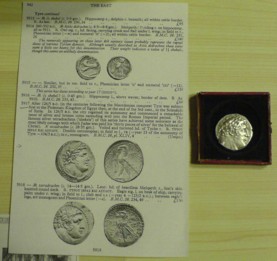 The fourth talk was by Graham Kirby in the style of Ronnie Corbett. He had always wanted a
shekel of Tyre because of its Biblical connections. Because it was expensive he sought guidance and advice from Maurice Bull
who suggested he attend the Oxford Coin Club. Protesting that he didn't like going into Oxford he was delighted to find that they met
virtually at the end of his road. At the December Birmingham Fair he acquired a specimen and duly took it to the Oxford Club, there he
was told to show it to Peter Finch -(what happened to Peter Finch?) "I'm Peter Finch" came a voice from a corner. The coin was duly
shown and approved. Graham then gave a brief history of Tyre and a description
of the coin, head of Melqarth on the obverse and an eagle standing on the prow of a ship carrying a palm under its right wing
and in the left field a club and the date letters θλ to the left and ∆ to right. Modern scholarship thinks this is the most
likely coin to be mentioned as being given to Judas for betraying Jesus. What was its value? Today the 30 pieces might equate to
120 days pay. Because the coin is in good condition it probably sat a long time in the temple treasury. The Bible tells us that
Judas later tried to give the money back but because it was blood money and therefore unclean the priests declined to put it back
in the temple treasury. Graham then passed the coin round.
The fourth talk was by Graham Kirby in the style of Ronnie Corbett. He had always wanted a
shekel of Tyre because of its Biblical connections. Because it was expensive he sought guidance and advice from Maurice Bull
who suggested he attend the Oxford Coin Club. Protesting that he didn't like going into Oxford he was delighted to find that they met
virtually at the end of his road. At the December Birmingham Fair he acquired a specimen and duly took it to the Oxford Club, there he
was told to show it to Peter Finch -(what happened to Peter Finch?) "I'm Peter Finch" came a voice from a corner. The coin was duly
shown and approved. Graham then gave a brief history of Tyre and a description
of the coin, head of Melqarth on the obverse and an eagle standing on the prow of a ship carrying a palm under its right wing
and in the left field a club and the date letters θλ to the left and ∆ to right. Modern scholarship thinks this is the most
likely coin to be mentioned as being given to Judas for betraying Jesus. What was its value? Today the 30 pieces might equate to
120 days pay. Because the coin is in good condition it probably sat a long time in the temple treasury. The Bible tells us that
Judas later tried to give the money back but because it was blood money and therefore unclean the priests declined to put it back
in the temple treasury. Graham then passed the coin round.
The fifth talk was by Gavin Scott on countermarks on coins. He started by saying that many countermarks were enigmatic,
rather like a detective mystery which could sometimes be resolved by thinking about why, where and when the countermark was applied.
He then showed ten countermarked items, summarised as follows:
- Hollymount a small village in Ireland
- County Armagh on a cartwheel penny possibly for trade purposes
- A bust of Byron in circle on cartwheel penny, possibly a trial for a button punch
- DRIVE on a very worn George III halfpenny brandmark for a Sheffield cutler
- 1772 on George III halfpenny, also a Sheffield brandmark
- LSD in diamond on a bun penny
the last three are all probably tests of punches.
- Crown above initials, a misleading and widely used mark often mistaken for a west Indies counterstamp
- JDV in lozenge on a very worn Mexican coin – so probably a Hacienda token
- Corkscrew and B H - almost certainly a brand mark
- Two birds in an oblong - a fine punch
Basically these are probably all punch tokens and shows how easy it is to be confused or misled by countermarks.
Many countermarks cannot be attributed to a specific issuer.
The standard of all five talks was very high and much appreciated and it was difficult to pick one better than the others.
A vote was taken and the four runners up all received equal votes but Michael Gouby received the most votes and he was duly
awarded the Marc Myhill memorial shield.
Spring Social.
The Spring Social skittles evening is being planned far Saturday ??th April, at the Red Lion in Theale. If you are interested in
coming along to this fun evening please sign up at the next meeting. A sign-up list will be adjacent to the signing in book.
The cost is £12 per head including buffet and prizes, monies payable to David. Drinks are extra.
Quiz Answers.
The answers to Michael's quiz are given here. The descriptions of coins from an auction site are
given in the order the pictures were displayed.
Future Events.
London coin Fair - Holiday Inn, Bloomsbury, 10th February
Baldwin's Auctions -11, Adelphi Terrace, London 11th February
Birmingham Coin Fair - Motorcycle museum, 11th February
Past Events
In January 1977 members heard a talk by Nicholas Lowick of the BM on "Islamic Bronze Coinage, Mints and Mining".
Ten years later George Berry talked on "17th Century Tokens of Buckinghamshire".
In 1997 the January meeting was by Maurice Bull entitled "Halfcrowns of the Four Georges"
 Michael first warned club members to beware of some very high quality modern forgeries
coming out of China. He showed two actual examples and a list compiled by a London dealer showing all the the ones they had so far
encountered. They were struck in good metal (silver or gold) of good weight (within acceptable limits), had very convincing toning
and had fooled many experienced dealers and collectors.
Michael first warned club members to beware of some very high quality modern forgeries
coming out of China. He showed two actual examples and a list compiled by a London dealer showing all the the ones they had so far
encountered. They were struck in good metal (silver or gold) of good weight (within acceptable limits), had very convincing toning
and had fooled many experienced dealers and collectors.
 The first talk was by Tony Martin about the "Prince of Poyais". Gregor MacGregor, son
of Gregor the Beautiful was born in Scotland in 1780. He served in the Peninsular war against Napolean and then went on to fight for
Simon Bolivar, helping to liberate South America from Spanish rule. He was so well thought of that he was allowed to marry Bolivar's niece
Josefa. After the war of liberation he turned to piracy. He captured the island of Amelia off the coast of Florida and tried
(unsuccessfully) to sell it to the USA. He then called in at a place called the Mosquito Coast in central America where he got drunk
with a local chief called George Frederick Augustus who gave him 8 million acres of worthless land.
The first talk was by Tony Martin about the "Prince of Poyais". Gregor MacGregor, son
of Gregor the Beautiful was born in Scotland in 1780. He served in the Peninsular war against Napolean and then went on to fight for
Simon Bolivar, helping to liberate South America from Spanish rule. He was so well thought of that he was allowed to marry Bolivar's niece
Josefa. After the war of liberation he turned to piracy. He captured the island of Amelia off the coast of Florida and tried
(unsuccessfully) to sell it to the USA. He then called in at a place called the Mosquito Coast in central America where he got drunk
with a local chief called George Frederick Augustus who gave him 8 million acres of worthless land. David Pottinger showed a brass 6 sided token with central hole inscribed both sides
"Robert Tompkins Reading". He secured it from Michael who suggested he research it as it was unpublished as far as he knew. Six years
later David did and found out that RT was born in 1833 and moved to Reading in late 1855, setting up as an auctioneer. The earliest
trade directory listing is in 1859, showing him a horse and cattle auctioneer of 18 Oxford St. Reading. In 1860 he moved to 27, Broad St.
in the centre of Reading and 3 years later had expanded his activities to include a horse and carriage repository. In 1869 he moved
to 25, Friar St. (near the Boars Head Pub) and by 1874 had added "Royal" to his business title. In the 1871 census he is listed as living
here with his wife Sarah, 3 daughters and 4 servants. In 1876 and 1877 Hammond and Co. are listed as proprietors of his business but within
5 years he had resumed as proprietor. There followed several changes to the address and details of the business and on 7th February 1897
Tompkins died aged 63, but the business continued to at least 1911 (final directory listing) where motor cars were added to the items
traded.
David Pottinger showed a brass 6 sided token with central hole inscribed both sides
"Robert Tompkins Reading". He secured it from Michael who suggested he research it as it was unpublished as far as he knew. Six years
later David did and found out that RT was born in 1833 and moved to Reading in late 1855, setting up as an auctioneer. The earliest
trade directory listing is in 1859, showing him a horse and cattle auctioneer of 18 Oxford St. Reading. In 1860 he moved to 27, Broad St.
in the centre of Reading and 3 years later had expanded his activities to include a horse and carriage repository. In 1869 he moved
to 25, Friar St. (near the Boars Head Pub) and by 1874 had added "Royal" to his business title. In the 1871 census he is listed as living
here with his wife Sarah, 3 daughters and 4 servants. In 1876 and 1877 Hammond and Co. are listed as proprietors of his business but within
5 years he had resumed as proprietor. There followed several changes to the address and details of the business and on 7th February 1897
Tompkins died aged 63, but the business continued to at least 1911 (final directory listing) where motor cars were added to the items
traded. The third talk was by Michael about Cruikshanks Anti-hanging note. The Napoleonic wars
resulted in an upsurge of hoarding and a resulting need for more money. This resulted in the Bank of England hastily producing
£1 and £2 banknotes (previously the smallest denomination was £5) and these were easily forged. Also Prime Minister Pitt passed
the "restriction of cash payment" act which meant that notes could not be converted into cash (coin) until the act was rescinded
(which was not until 1821). As most of the population was illiterate the number of fake banknotes surged to 10,000 and by 1817 the
total value of fake notes in circulation was £37,040. Between 1773 and 1796 only 3 people were capitally convicted of forgery
but between 1797 and 1817 the figure had risen to 313. By 1819 many people (including Cruikshank) blamed the Government and
particularly the Bank of England for this state of affairs and the note was produced to highlight this.
The third talk was by Michael about Cruikshanks Anti-hanging note. The Napoleonic wars
resulted in an upsurge of hoarding and a resulting need for more money. This resulted in the Bank of England hastily producing
£1 and £2 banknotes (previously the smallest denomination was £5) and these were easily forged. Also Prime Minister Pitt passed
the "restriction of cash payment" act which meant that notes could not be converted into cash (coin) until the act was rescinded
(which was not until 1821). As most of the population was illiterate the number of fake banknotes surged to 10,000 and by 1817 the
total value of fake notes in circulation was £37,040. Between 1773 and 1796 only 3 people were capitally convicted of forgery
but between 1797 and 1817 the figure had risen to 313. By 1819 many people (including Cruikshank) blamed the Government and
particularly the Bank of England for this state of affairs and the note was produced to highlight this. The fourth talk was by Graham Kirby in the style of Ronnie Corbett. He had always wanted a
shekel of Tyre because of its Biblical connections. Because it was expensive he sought guidance and advice from Maurice Bull
who suggested he attend the Oxford Coin Club. Protesting that he didn't like going into Oxford he was delighted to find that they met
virtually at the end of his road. At the December Birmingham Fair he acquired a specimen and duly took it to the Oxford Club, there he
was told to show it to Peter Finch -(what happened to Peter Finch?) "I'm Peter Finch" came a voice from a corner. The coin was duly
shown and approved. Graham then gave a brief history of Tyre and a description
of the coin, head of Melqarth on the obverse and an eagle standing on the prow of a ship carrying a palm under its right wing
and in the left field a club and the date letters θλ to the left and ∆ to right. Modern scholarship thinks this is the most
likely coin to be mentioned as being given to Judas for betraying Jesus. What was its value? Today the 30 pieces might equate to
120 days pay. Because the coin is in good condition it probably sat a long time in the temple treasury. The Bible tells us that
Judas later tried to give the money back but because it was blood money and therefore unclean the priests declined to put it back
in the temple treasury. Graham then passed the coin round.
The fourth talk was by Graham Kirby in the style of Ronnie Corbett. He had always wanted a
shekel of Tyre because of its Biblical connections. Because it was expensive he sought guidance and advice from Maurice Bull
who suggested he attend the Oxford Coin Club. Protesting that he didn't like going into Oxford he was delighted to find that they met
virtually at the end of his road. At the December Birmingham Fair he acquired a specimen and duly took it to the Oxford Club, there he
was told to show it to Peter Finch -(what happened to Peter Finch?) "I'm Peter Finch" came a voice from a corner. The coin was duly
shown and approved. Graham then gave a brief history of Tyre and a description
of the coin, head of Melqarth on the obverse and an eagle standing on the prow of a ship carrying a palm under its right wing
and in the left field a club and the date letters θλ to the left and ∆ to right. Modern scholarship thinks this is the most
likely coin to be mentioned as being given to Judas for betraying Jesus. What was its value? Today the 30 pieces might equate to
120 days pay. Because the coin is in good condition it probably sat a long time in the temple treasury. The Bible tells us that
Judas later tried to give the money back but because it was blood money and therefore unclean the priests declined to put it back
in the temple treasury. Graham then passed the coin round.